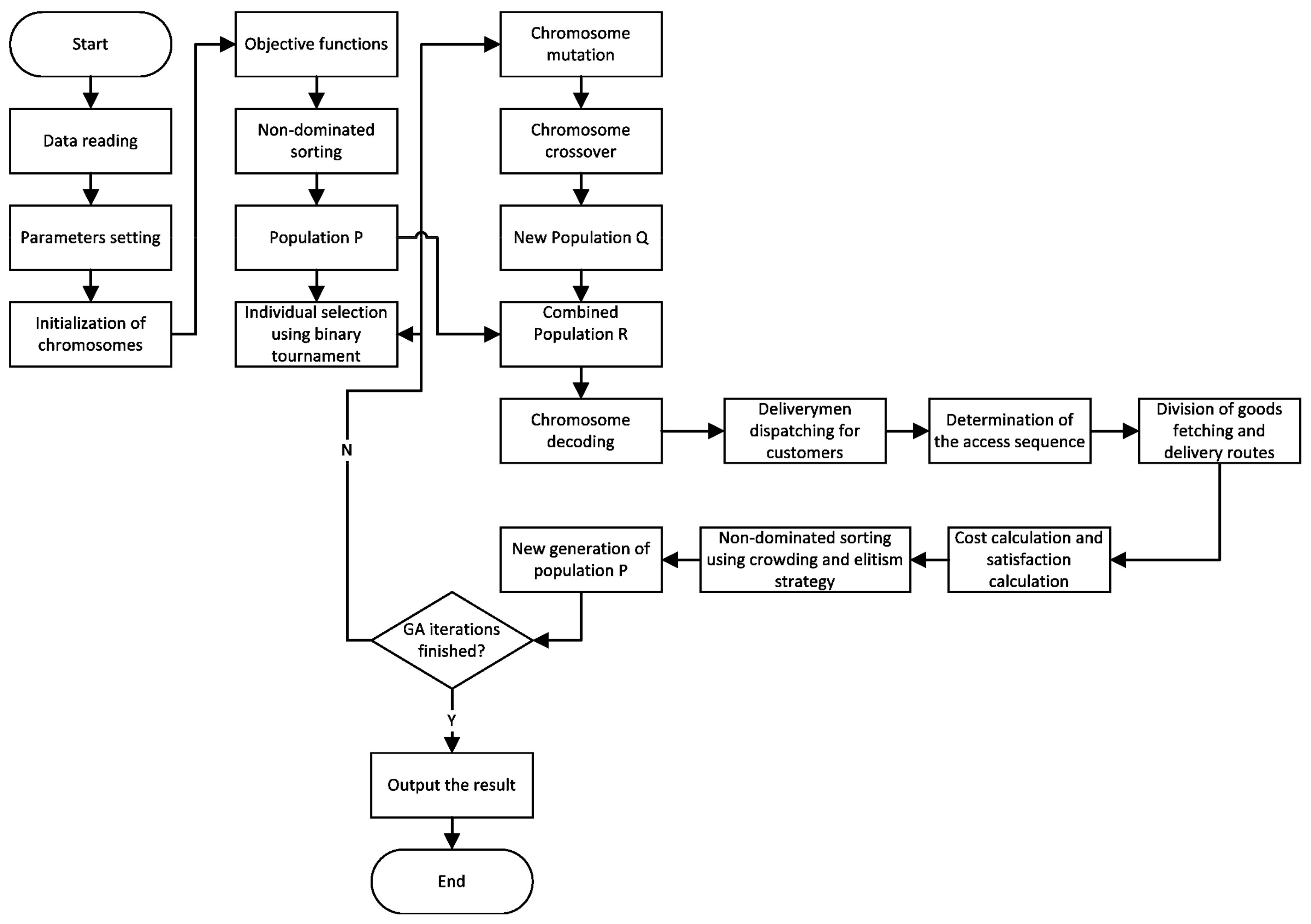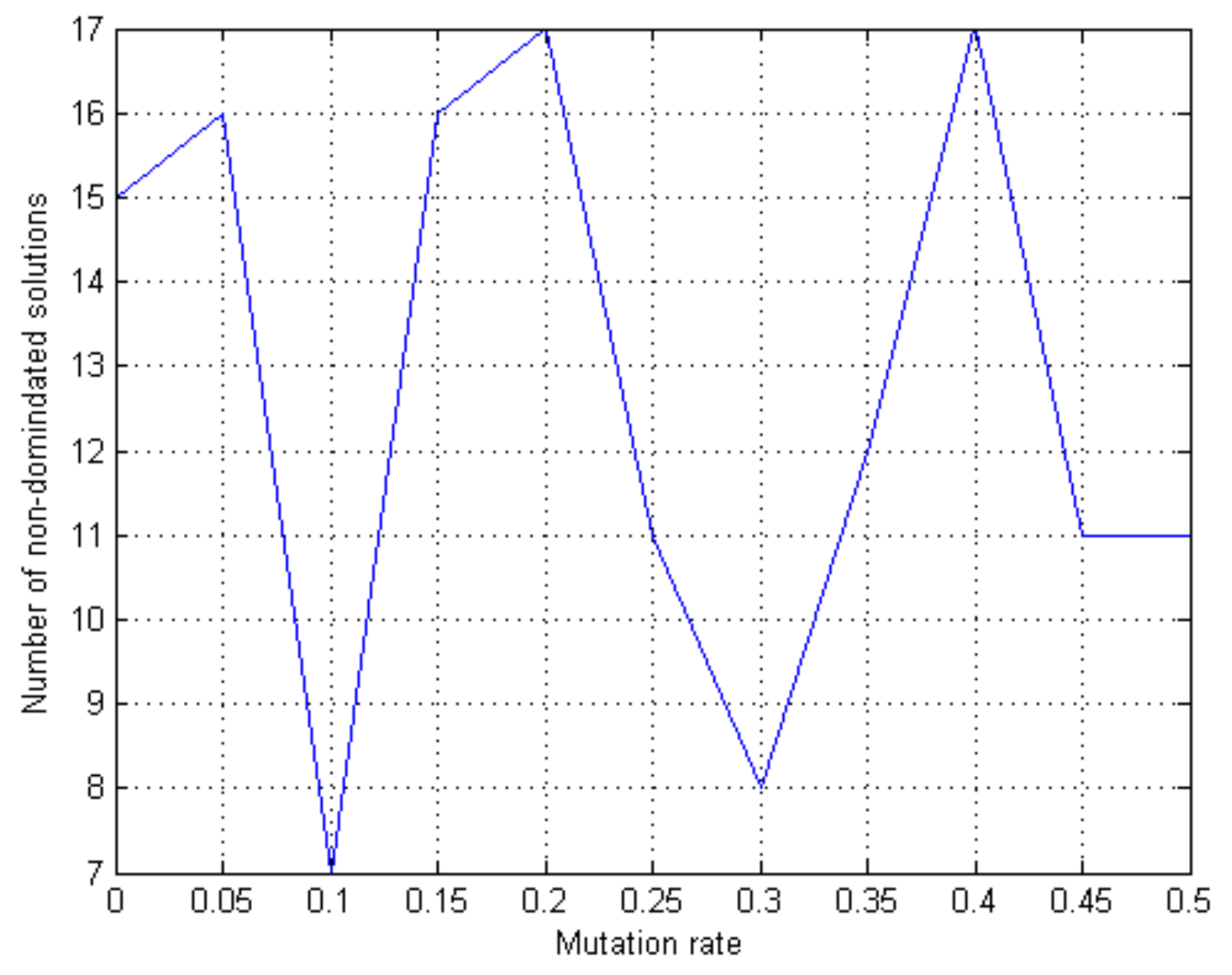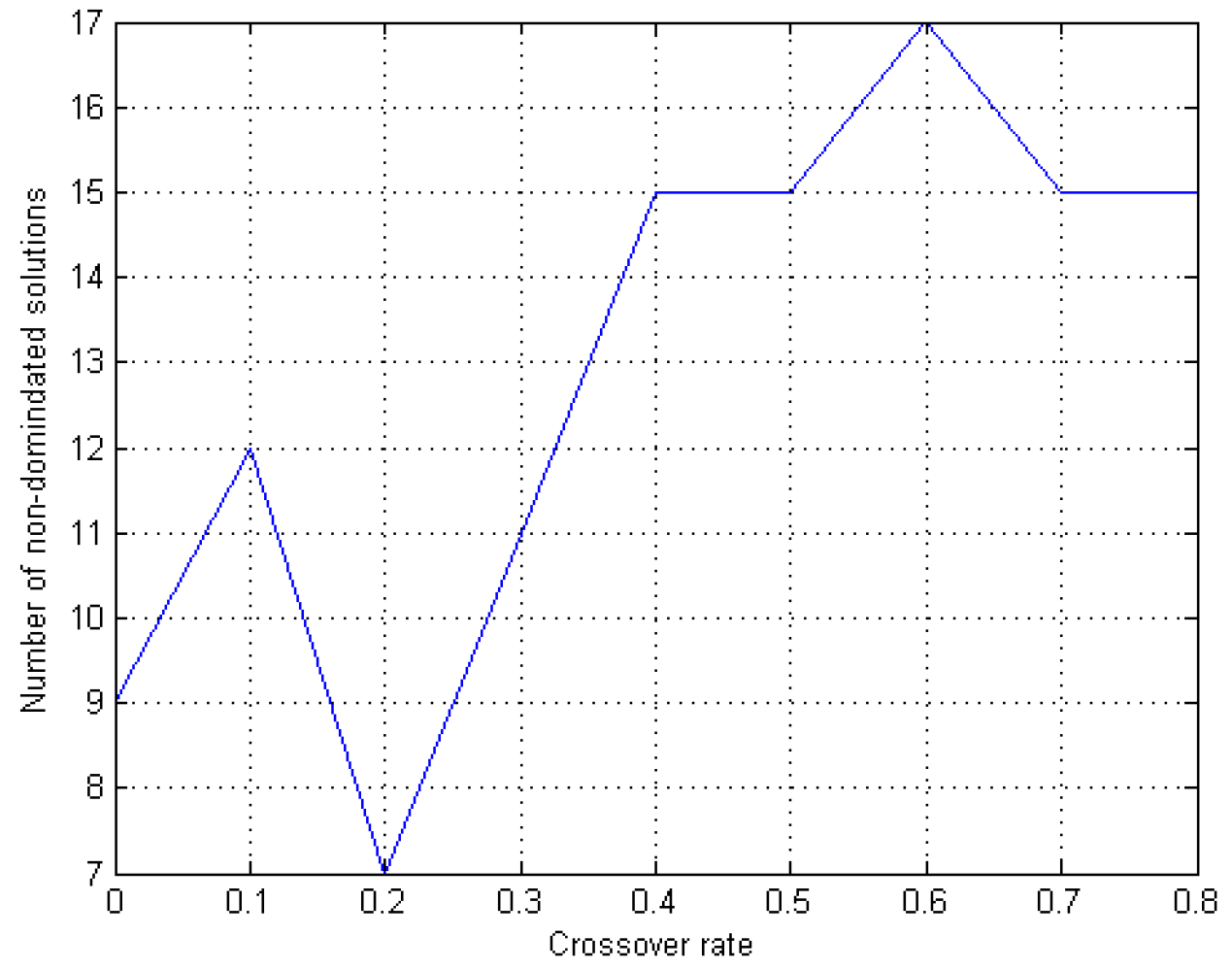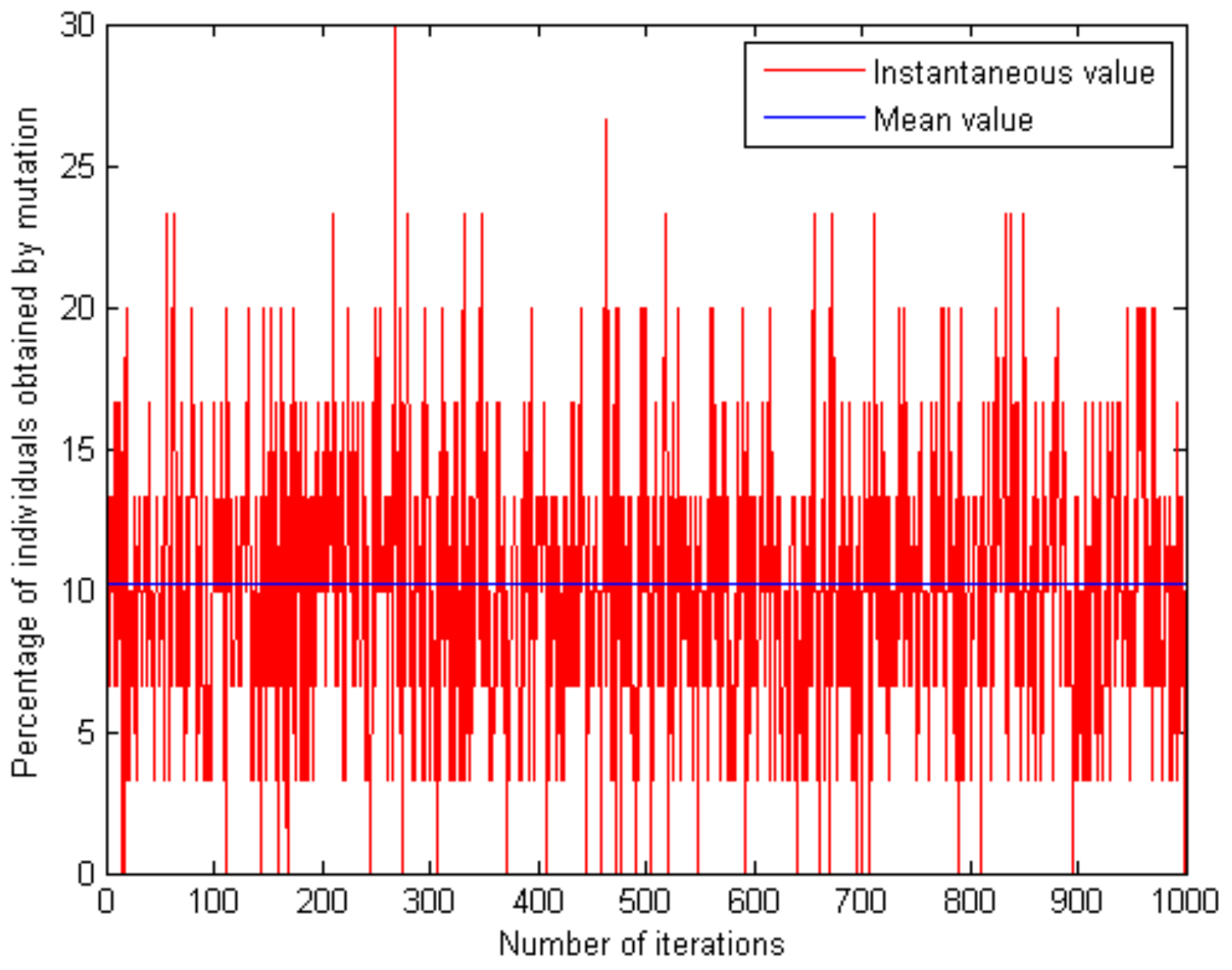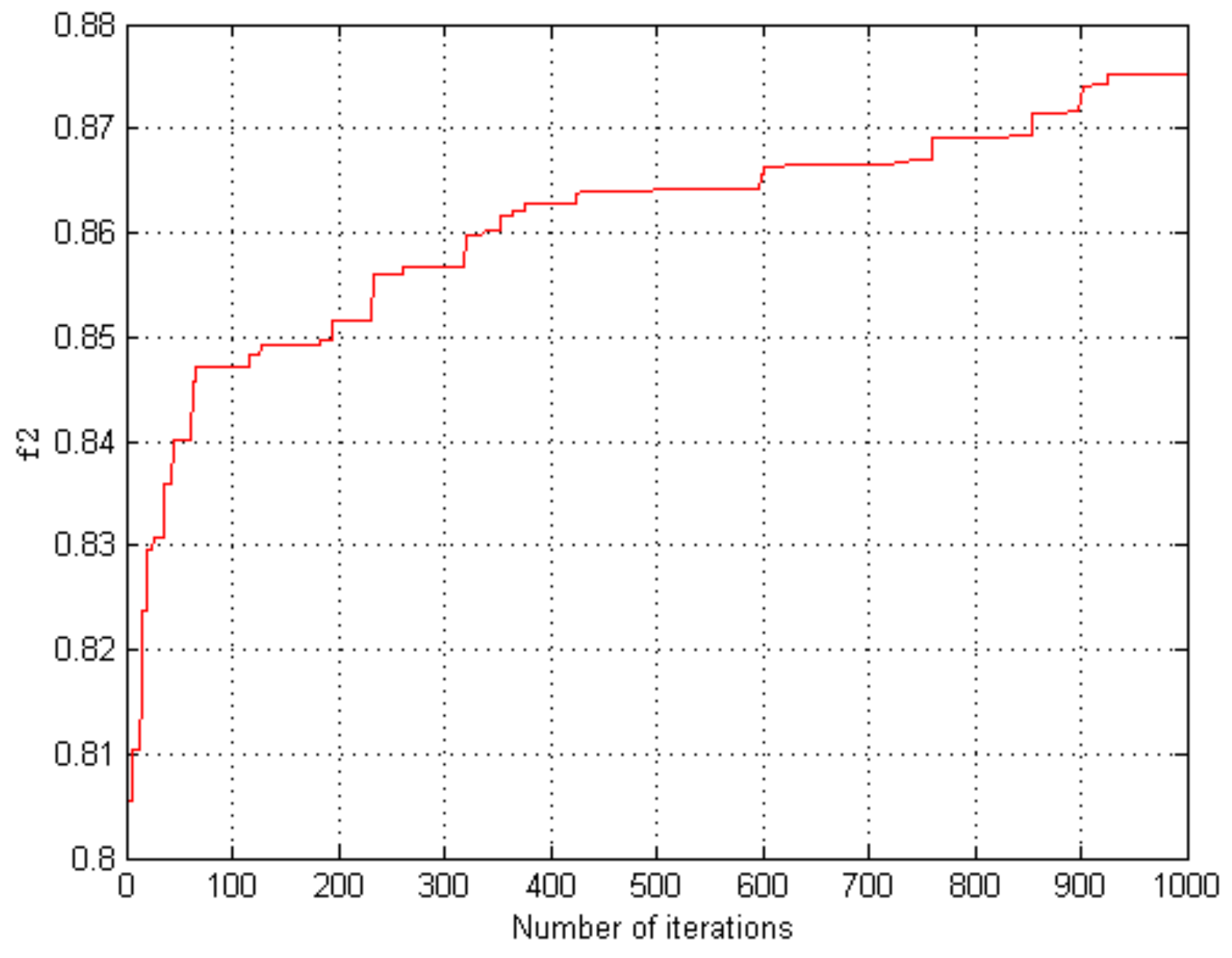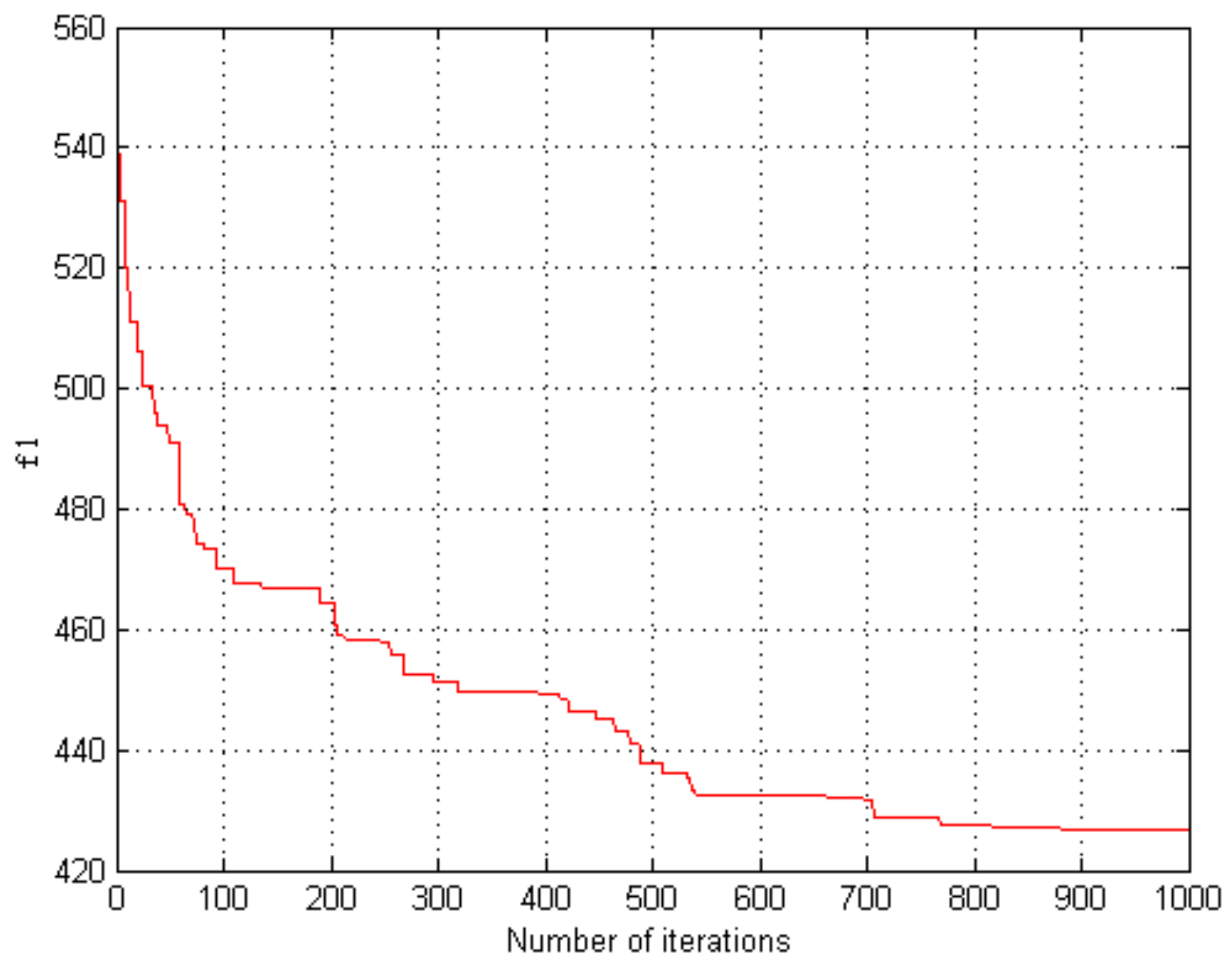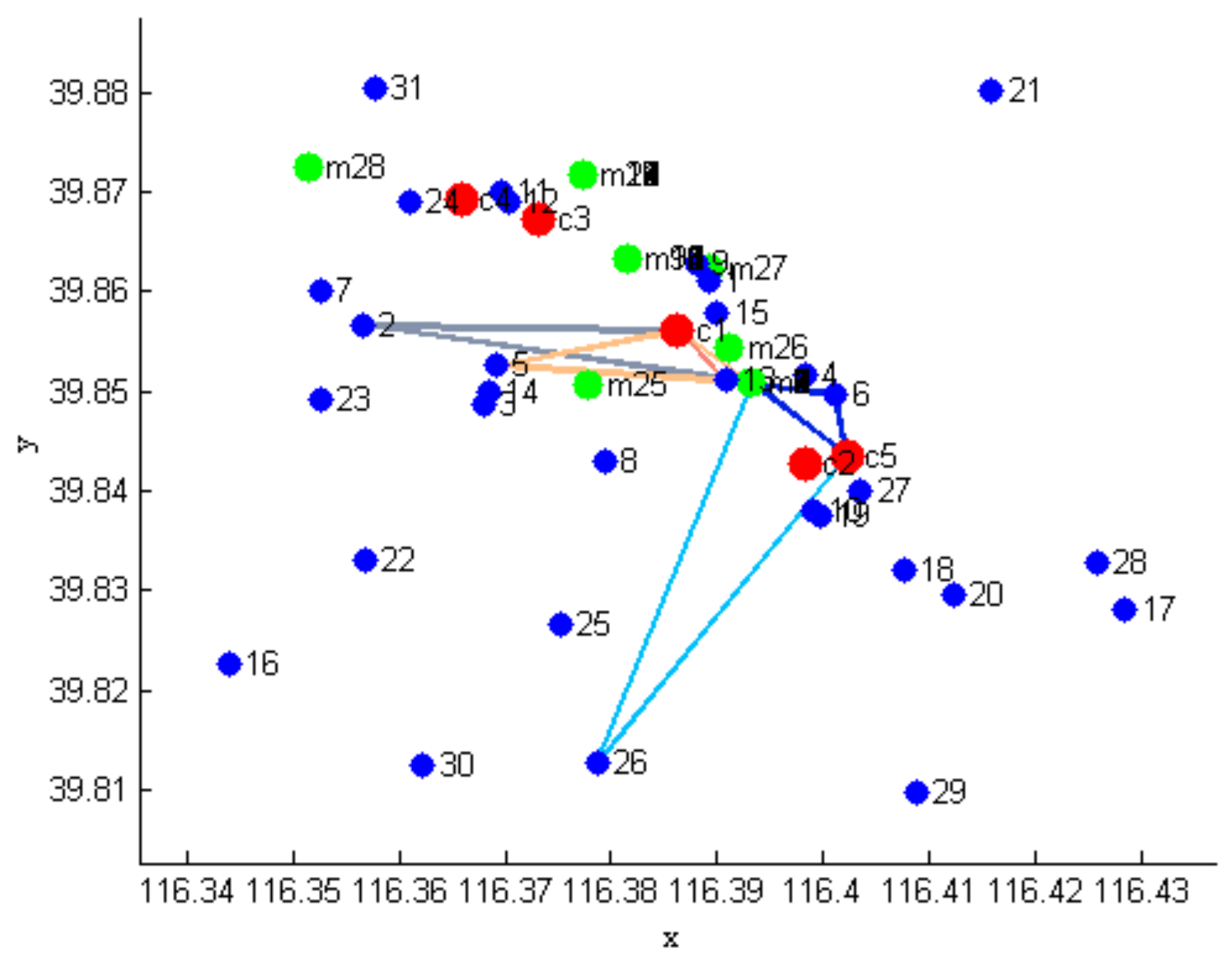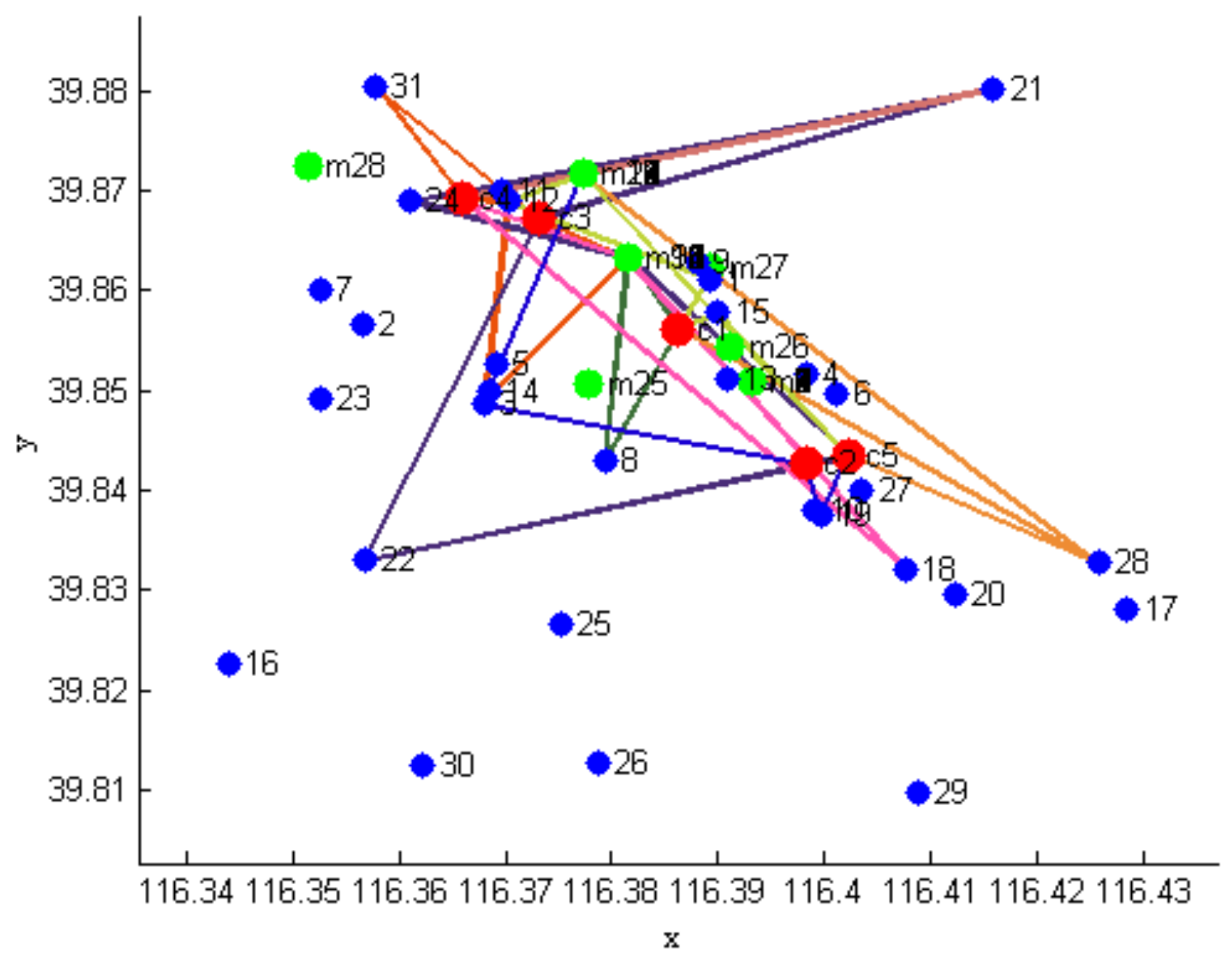1. Introduction
In the era of mobile internet, people can easily enjoy home delivery of commodities and services with the expansion of the scale of on-line shopping, which promotes the upgrading of the level of logistics and distribution services. As a newly emerged logistics distribution pattern under such circumstances, instant distribution has a most important feature which lies in its high requirement on timeliness. The delivery of goods is normally finished within 3 h, sometimes even within 30 min after the customer makes an order on the Internet. The prosperous development of instant distribution has also raised high demands on the logistics network. Therefore, optimization of logistics resources should be better deployed and optimized to make the delivery more efficient, the delivery cost lower, and the customers more satisfied.
Optimization of logistics distribution vehicle routing, also known as vehicle routing problems (VRPs), is a core optimization problem in the logistics network. It was first put forward by Dantzig and Ramser (1959), proposing a near optimal solution based on a linear programming formulation in the shortest routes [
1]. The objective function [
1,
2] based on total mileage or total cost was widely used in the early stage, and then practical factors, such as vehicle capacity limitation [
3], the multi-distribution center [
4], the time window [
5,
6,
7], costs of quality deterioration, and carbon emissions [
8] were introduced. These factors made the objective conditions of vehicle routing optimization more closely combined with the actual problems.
In addition to these objective conditions, in recent years, more and more researchers have focused on introducing customer satisfaction factors into the distribution route optimization problem. Customer satisfaction refers to the matching degree between the user’s experience and the previous expectation in the process of using products and services. In instant distribution, consumers pay more attention to the service process time satisfaction of logistics distribution, that is, the impact of service time between customer order and delivery on customer satisfaction. Lan, et al. [
9] distinguished order production, inventory-oriented production, mass customization production, and other evaluation criteria applicable to different customer satisfaction and used the fuzzy analytic hierarchy process (FAHP) to model customer satisfaction. Qianwen, et al. [
10] proposed an improved fuzzy comprehensive evaluation method to measure customer satisfaction of takeaway distribution. Unlike most previous studies in literatures, Miranda, et al. [
11] introduced a hard time window, random travel, and service time into the multi-objective vehicle routing problem, taking the minimum operating cost and maximizing the service level as optimization objectives. Daya, et al. [
12] used the column generation heuristic algorithm to solve the vehicle routing problem. Miranda et al. [
13] introduced a hard time window, random travel, and service time into the multi-objective vehicle routing problem and took the two conflicting objective functions of the minimum operating cost and maximum service level as optimization objectives.
The multi-objective vehicle routing problem (MOVRP) is an extension of VRPs. Time windows are introduced into VRPs in logistics distribution, resulting in a combinatorial optimization problem [
14]. Different from single objective optimization, the optimal solution is a set of compromise solutions, namely the Pareto optimal solution set. The time window constraints may lead to total the distribution distance and number of service vehicles and may affect customer satisfaction [
15]. Therefore, under the constraints of the time window, solving the problem of minimizing the distribution cost and maximizing customer satisfaction are usually two conflicting goals. When the minimizing of the routing cost and the maximizing of customer satisfaction are affected by the time window, customer satisfaction affected by too late arrival time and (possibly) too early arrival time has been modeled as a weighted combination of distribution cost and punishment of corresponding customer satisfaction in vehicle routing problem with time window (VRPTW) [
16].
Researchers have proposed a series of multi-objective evolutionary algorithms (MOEAs) based on heuristic algorithms, such as the tabu search algorithm [
14], genetic algorithm [
17], simulated annealing algorithm [
18], and ant colony algorithm [
19], to solve the multi-objective vehicle routing problems. Deb [
20] proposed the fast nondominated sorting genetic algorithm version II (NSGA-II) with elitist strategy based on the NSGA, and the algorithm has become a comparative mark for performance comparison of multi-objective optimization. It adopted the strategy of fast nondominated sorting and elite selection and selects the individuals with higher adaptability through crowding coefficient operators. Researchers proposed some improved versions based on the basic NSGA-II in Reference [
20]. Tianyi, et al. [
21] adopted the strategies of crossover, mutation, and elite reserve to design the hybrid NSGA-II to solve the problem of allocating vehicles with faster time and less cost.
Previous studies are mostly aimed at traditional logistics distribution networks. Meanwhile, the function of the service level assumes that distributors need to wait when they arrive at customer points in advance, which does not meet the requirements of soft time windows and extreme speed distribution in instant distribution scenarios. They usually directly aim at route optimization of instant distribution. There are few studies on this topic. However, the existing path optimization modeling methods have the following main drawbacks in the application of instant distribution systems.
Firstly, the above literature generally assumes that there are one or more fixed distribution centers. On the one hand, deliverymen usually live in relatively concentrated commercial centers, such as fixed distribution centers. On the other hand, there are some deliverymen scattered in various locations who can accept dispatch or snatch orders at any time. Therefore, it is necessary to consider the two situations of riding cohabitation and scattered riding, as well as the time when the deliveryman arrives at the merchant and the time when the merchant delivers the goods in the modeling.
Secondly, for the modeling of customer time satisfaction, symmetrical time windows are generally used in the existing literature, that is, the delivery time cannot be earlier than the earliest time expected by the user, nor later than the latest time expected by the user. Once the limit is exceeded, it is modeled as a penalty fee and added to the objective function. In instant distribution, users expect the sooner they arrive, the better. Therefore, the penalty cost of arriving too early does not accord with the reality of instant distribution.
Thirdly, considering that the cost of traditional logistics distribution often accounts for the main part of the distribution cost, the transportation cost is modeled as proportional to the distance traveled. But in instant distribution, logistics enterprises usually pay the freight by each order, which is called the pay-to-order mode. Within the typical urban service radius, the distance will not cause the difference of freight. This leads to the difference between the distribution mileage and the traditional distribution service, which is not reflected directly in the freight, but, due to the longer time for delivery, more transportation resources are occupied. In addition, the penalty cost beyond the expected time window of customers should also be considered.
Based on the particularity of the instant distribution scenario mentioned above, this paper establishes a comprehensive route optimization model of the instant distribution system, in view of the current situation that the existing research does not consider the particularity of the instant distribution scenario adequately. The impact of customer time satisfaction is considered in the proposed model. The innovation and contribution of this paper are mainly as follows:
In view of the instant distribution service scenario, a route optimization model of the instant distribution system is proposed. In the model, the time when the deliveryman arrives at the merchant, the time needed for the delivery of the instant distribution merchant, and the upper limit of the deliveryman distribution are considered, which are in line with the actual situation of the instant distribution and are not included in previous research work.
A customer time satisfaction function based on a one-sided soft time window is established as one of the objective functions. The total cost function of joint distribution is used to establish a multi-objective optimization model of instant distribution.
In the total cost function, the distribution cost is calculated by the pay-to-order mode. The influence of mileage is reflected in the occupation of transportation resources, not directly converted into freight. The penalty function of time cost is designed based on the difference between the actual distribution time and the user’s expected latest delivery time.
The above model considers the particularity of instant distribution and adopts the above assumptions, which are more in line with the actual service scenario of instant distribution, which undoubtedly increases the credibility of the model and the applicability of the conclusions. After establishing the distribution routing optimization model of the instant distribution system, it is solved by the NSGA-II. In the design of the algorithm, a double-layer chromosome coding is established based on the mapping of deliverymen to nodes and the access order. The total cost and customer time satisfaction are jointly optimized in the sense of Pareto optimization. The results of the instant distribution route optimization model based on customer time satisfaction are compared and analyzed with those of the model without considering customer time satisfaction and only considering the total cost of distribution, and more conclusions are obtained. This research has important practical significance for optimizing resource allocation, reducing logistics costs, and improving logistics service levels and customer satisfaction of the instant distribution platform.
The rest of this paper is organized as follows. The problem of vehicle routing optimization is described according to the real instant distribution scenarios and the characteristics of instant distribution is analyzed in
Section 2. In
Section 3, we formulate a multi-objective optimization model for the instant distribution system based on the total cost function and time satisfaction of the customer and we take some actual factors of instant distribution into account. Dual-layer chromosome coding based on the deliveryman-to-node mapping and the access order was conducted, and the NSGA-II algorithm is used to solve the problem in
Section 4. Numerical results are carried out in
Section 5 to evaluate the performance. Finally, this paper concludes by identifying some potential researching points that can be carried out in future work.
3. Mathematical Model
Orders in an instant distribution system involve many unforeseen circumstances. There are normally a great amount of orders to be dealt within certain periods of time. Additionally, there are high requirements on timeliness for these orders. In addition, customer comments have a great influence. Therefore, customer satisfaction becomes a priority. Therefore, a multi-objective optimization model is established based on the consideration of customer satisfaction and total delivery cost.
It is assumed that the total number of merchants in the distribution system is , the total number of customers is , the total number of deliverymen is , the set of merchants is , the set of customers is , the set of deliverymen is , the average driving speed of deliverymen is , the maximum number of orders for deliverymen is , the -th merchant’s distribution demand quantity is , the maximum number of orders that the -th merchant can handle is , the number of orders demanded by the -th customer is , whether Deliveryman delivers goods from Merchant to Customer is (= 1 if yes, = 0 if no), whether Deliveryman passes Merchant is (= 1 if yes, = 0 if no), the distance between the -th deliveryman and the -th merchant is , the distance between the -th merchant and the -th customer is , the number of orders delivered from the -th merchant to the -th customer is , and the delivery cost of each order is yuan/order.
The instant distribution system is highly sensitive to time, so the time taken in the delivery process is included in the total cost. The time cost includes the time cost for the delivery process and the time cost for the deliveryman to reach the merchant and wait before the start of the delivery. The delivery time cost is the time for the deliveryman to arrive at the destination multiplied by the time cost coefficient. The waiting time cost is the time cost produced from the fact that the merchant does not finish the preparation of goods when the deliveryman arrives at the merchant’s location. In addition, when a customer makes an order, the latest goods handover time will be specified in the order, once the total delivery time exceeds the specified latest handover time, and some time penalty cost will be incurred. The excessive time window cost is the penalty fee incurred from the deliveryman’s failing to deliver the goods to the customer within the specified time. It is assumed that the time between Customer ’s making an order from Merchant and the start of the delivery of the goods is ; the time the deliveryman spends to arrive at Customer ’s place after he receives the order and starts from his place is ; the unit time cost coefficient is ; the latest time for the goods to be handed to Customer after he makes an order in Merchant is ; the penalty coefficient in case the deliveryman arrives at the customer’s place in a time exceeding the time window is .
This paper focuses on the distribution of goods, so the influence of the quality of goods before their delivery starts is not considered. Meanwhile, modeling for customer satisfaction only has one judgement dimension, which is the delivery time. It is assumed that the time window for Customer
’ s receiving service from the
i-th Merchant is
. If deliveryman
k arrives at the customer’s place later than the latest service ending time that the customer can accept, which is
, the customer will be unsatisfied, leading to a reduction of customer satisfaction. It is noted that this customer satisfaction modeling method is different from the commonly used bilateral time window function. The bilateral time window function considers that customer expectation of distribution time has an expected range. Advance and lag will reduce satisfaction. It is suitable for routine logistics distribution scenarios, such as warehouse distribution, but not for instant distribution. However, in most cases, customers have some tolerance for the delay of goods handovers, but if the goods arrive before their expectation, customers usually do not care. It is assumed that the latest service time that a customer can tolerate is
. Customer satisfaction is inversely proportional to the delayed service time, as shown in
Figure 2.
Under the condition that the total delivery cost and customer satisfaction are considered comprehensively, the following multi-objective optimization model is established. The model includes two objective functions, namely, minimum total cost (minC) and maximum customer satisfaction (maxS):
Constraint conditions:
In this model, Objective (1) is the objective function of the total delivery cost. Item 1 on the right side of the equation is the total cost of the deliveryman from the merchant to the customer. Since it is paid on an order, this item has nothing to do with the distance. Item 2 is the total delivery time cost of the deliveryman from the merchant to the customer. The delivery time is calculated by dividing the distance from the merchant to the customer by the vehicle driving speed and then multiplying by the occupancy cost coefficient per unit time. Item 3 is the time cost of the deliveryman waiting at the merchant. If the delivery time of the merchant is less than or equal to the time of the deliveryman arriving at the merchant, there is no need to wait. The result of this item is 0. Otherwise, the time cost of this part is obtained by multiplying the difference between the delivery time of the merchant and the arrival time of the deliveryman by the occupancy cost coefficient per unit time. Item 4 is the penalty cost incurred when the total delivery time exceeds the latest handover time. Objective (2) is the objective function of customer time satisfaction, and the definition of time satisfaction is shown in Constraints (3) and (4), which is reflected as a kind of soft time window constraint. When the total delivery time is later than the end time of the service accepted by the customer, but not more than the service time tolerated by the customer, the customer time satisfaction is directly proportional to the difference between the service time tolerated by the customer minus the actual delivery time. When the delivery time exceeds the service time that the customer can tolerate, the customer time satisfaction drops to 0. Constraint (5) defines as a variable of 0–1, indicating whether there is a distribution relationship between Deliveryman distribution from Merchant to Customer . If there is a distribution relationship, take 1, otherwise, take 0. Constraint (6) restricts the number of orders delivered by each deliveryman to an upper limit of . Constraint (7) restricts the distribution of Deliveryman from Merchant to Customer . If there is a distribution relationship, it must simultaneously satisfy the requirement of passing through Merchant . Constraint (8) indicates that the total delivery time is equal to the sum of the time from the current position of the deliveryman to the merchant, the time for the deliveryman to wait at the merchant, and the time from the merchant to the customer. Constraint (9) restricts the order quantity of each merchant’s customers to be non-negative. Constraint (10) defines and as 0–1 variables. Constraint (11) indicates that the order quantity of each customer is equal to the sum of the orders placed by each merchant. Constraint (12) constrains the order quantity placed by the customer at the merchant not to exceed the upper limit of the total order quantity of the merchant.
4. Solution Methodology
4.1. NSGA-II
A genetic algorithm (GA) was adopted to solve the problem based on the single-objective programming model. The NSGA-II, which uses nondominated sorting, a crowding distance operator, and an elitist strategy, has many advantages, including maintaining population diversity, avoiding the loss of parent excellent individuals, and so on. It can constantly optimize the optimal solution set and is suitable for solving logistics distribution problems with the multi-objective optimization model [
20].
The solving procedures are as follows, as shown in
Figure 3:
Step 1: The population algebra is set as . The population starts with random initialization. Nondominated sorting of is performed to initialize the rank value of each individual.
Step 2: The population algebra is set as .
Step 3: Individuals are selected from using binary tournament selection. Crossovers and variations are performed to generate the new generation of population .
Step 4: and are combined to generate the combination population .
Step 5: Nondominated sorting of is performed, with crowding and the elitism strategy used to select N individuals which form the new generation of population .
Step 6: Skip to Step 3 and a loop operation is performed until the end condition is met.
In Step 1 and Step 5 of the algorithm, a nondominated sort was used. Fast nondominated sorting was adopted to stratify the population according to the level of non-inferior solutions of individuals to make the solution close to the Pareto optimal solution. This was a process of adaptive value grading, circularly. First, the dominant groups in the solution set were constructed, denoted by . Then, the i-th individual was given a nondominated rank, denoted by the , which was set to 1 and removed from the group. We continued to get the nondominated solution set in the rest of the group, denoted by , and the individuals in were given = 2, so we continued until the entire population was layered.
The selection strategy in Step 3 adopts the binary championship method. A certain number of individuals were taken out of the population at a time for sampling back, and then the individual with the best crowding metric was selected to enter the offspring population. The process was repeated until the new population size reached the original population size.
The mutation operation in Step 3 was implemented by a 2-interchange mutation operator. Firstly, two random natural numbers and were generated, and then the and genes were exchanged to realize the mutation process. The crossover operation adopted a two-point crossover. Firstly, two chromosomes were randomly selected as the male parent to produce two random natural numbers and . Then, the gene fragments between the two male chromosomes and were exchanged to obtain two progeny chromosomes.
Compared with the basic NSGA, the improvements of NSGA-II mainly lie in three aspects: Firstly, adopting the fast nondominated sorting algorithm, which greatly reduces the complexity of the algorithm; secondly, putting forward the crowding strategy, which uses the crowding degree and crowding degree comparison operator, instead of the fitness sharing strategy in the NSGA algorithm; thirdly, adopting the elite retention strategy, which can retain the superiority of the parent as much as possible and avoid losing the best individuals.
4.2. Detailed Design
Detailed design of using the NSGA-II to solve instant distribution routing problems was performed. The design is mainly for designing chromosome coding and decoding processes.
The chromosome coding process was completed during population initialization. The coding method is as follows:
Double layer coding is performed for demand points, deliverymen, and merchants. The first layer coding is to specify the deliverymen belonging to corresponding nodes. It shows which deliveryman should serve which node, using integer coding with a length of . The genetic locus is an integer [1,], denoting which deliveryman serves a specific node. The second layer coding is to specify the node access sequence. The coding length is ,which is a non-repetitive sorting of integers 1~, where represents the total number of orders. For example, if = 4 = 3, a legal chromosome can be represented as [1,3,3,2,5,4,2,1,3,6]. The first layer coding of deliverymen belonging to various nodes is represented as 1,3,3,2, meaning that node 1 is served by deliveryman 1, node 2 is served by deliveryman 3, node 3 is served by deliveryman 3, node 4 is served by deliveryman 2, and so on. The second layer coding for the node access sequence is represented as 5,4,2,1,3,6, meaning that node 5 is the first to be accessed, followed by node 4, node 2, and so on. The division of subpaths is also in such an order, according to the deliveryman’s loading limitation and time window.
The chromosome decoding process is as follows:
All serial numbers of nodes served by deliveryman 1 are fetched according to their sequence in chromosome to get the serial numbers of nodes served by each deliveryman ();
Division of routes for is performed;
The division starts from the first node in ;
When a node is arrived at, it is judged if the deliveryman can load all the goods in the node. If so, the goods will be loaded and the distribution quantity of the demand point will be emptied, and then skip to (d). If not, skip to (c);
Partially delivered goods in the demand point are loaded, until the vehicle is full, and then the distribution quantity of the demand point will be updated. The deliveryman then travels to the location of customer and then returns to the node. When the process is finished, skip to (b);
It is judged if all the nodes have been accessed. If not, the deliveryman will go to the next node, and then skip to (b). If so, skip to (e);
The access path and the deliveryman’s loading situation are the output.
Path calculation is performed according to the access path and the deliveryman’s loading situation obtained in A.
In addition, at the stage of chromosome variation, different variation methods were adopted for the first layer coding and second layer coding. Single variation was adopted for the first layer coding. A random natural number was generated. The number denoted that the gene in the position was mutated. Random variation was used to make the gene in the position mutated. Double-point reciprocity was adopted for the mutation in the second layer coding. Two random natural numbers were generated. The genes in the and positions were exchanged. At the stage of chromosome selection, the selection was performed through roulette selection.
In the above algorithm, the distribution path was represented by chromosome coding, which included two segments from the location of the deliveryman (including the two types of location of the deliveryman settlement and the deliveryman scattering point) to the merchant and from the merchant to the user. This was the characteristic of the instant distribution system, which was different from the traditional logistics distribution service. In a typical warehouse distribution scenario, the distribution path incorporates only the distance from the distribution center to the user demand point. There are two segments in the coding process of instant delivery, which introduces more complexity. In addition, in the decoding process, it also reflects the important feature that there is a ceiling on the number of delivery orders per deliveryman in instant distribution.
6. Conclusions
In the instant distribution system, it is normal for users to make sudden orders. The order quantity density and the timeliness requirement is high, and the impact of user evaluation is very large. In this context, user satisfaction is very important, especially when users are not satisfied and giving bad reviews, which has a great impact on the traffic of the merchants. In the instant delivery service scenario, the most critical customer satisfaction is the requirement of service time. Therefore, this paper takes customer time and user satisfaction as an important factor to consider, which is the starting point of modeling the problem of instant distribution routing optimization.
In this paper, a distribution routing optimization model for the instant distribution system is proposed according to the real service situation of instant distribution. A multi-objective optimization model is established based on the minimum total cost and maximum customer satisfaction. Some problems that exist in instant distribution, but were not considered in previous studies about optimization of distribution routing, were considered, including the coexistence of deliverymen gathering in a concentrated way and distributing dispersedly, pay-to-order, and the fact that it takes some time for the deliveryman to arrive at the merchants and for the merchant to prepare goods before the start of their delivery, which limits the number of orders deliverymen can finish, this limiting customer satisfaction and causing constraints based on the soft time window, and so on. In the total cost, both the delivery cost and the penalty fee generated, when the arrival time of goods exceeded the customer’s expectation, were considered. These considerations in the modeling work have made the results of this research more practical in guiding the optimization of routing for instant distribution systems.
The established multi-objective instant distribution routing model uses the NSGA-II to solve the problem. In the design of algorithms, double chromosome coding is established based on deliveryman-to-node mapping and the access sequence, and optimization of total cost and customer satisfaction are combined under Pareto optimality. According to the computational results of numerical examples, the proposed model, using the NSGA-II to solve the optimization of routing for the instant distribution system, can obtain an approximately optimal solution considering both the total cost and customer satisfaction, which can make the system’s transport capacity resource fully optimized. Moreover, the established multi-objective programming model increases customer satisfaction at the cost of a tiny increase in the delivery cost, with the number of deliverymen slightly increased to meet the on-time delivery needs of customers. The research of this work can provide a reasonable scheduling scheme for instant distribution platforms and can help them reduce the distribution cost by optimizing the vehicle routing and maximizing the utilization of transportation resources. It can shorten the delivery time of instant delivery and match the time window needs of different users to improve the satisfaction of users of the delivery service.
This work made some contributions on vehicle routing problems in instant delivery. However, there were some limitations which need to be further studied. Firstly, large-scale instant delivery during busy hours was not considered in this study. Instant customer time tolerance will be stricter during busy hours. Therefore, in the follow-up work, we need to model the customer’s time window with busy hours distinguished, so that the optimization result of the distribution path can better match the needs of customers. Another limitation of this study is that the dynamic vehicle routing problems are not modeled for instant delivery. However, in the actual instant delivery scenario, customers can obtain the information of the expected delivery time in real time, and if the expected delivery time is exceeded, the order may be cancelled. Therefore, it is necessary to consider the dynamic optimization of the vehicle path according to the real-time dynamic demand of customers. Moreover, since a large amount of user data has been accumulated in the distribution platforms, deep learning can be used to model and predict customer demand, real-time system capacity, merchant stocking capacity, and deliveryman decision-making behavior. Another interesting idea is to include the carbon emissions reduction as another objective in vehicle routing optimization of instant distribution, because the reduction of pollutant emissions has become a popular issue in the research field of logistics distribution routes.


